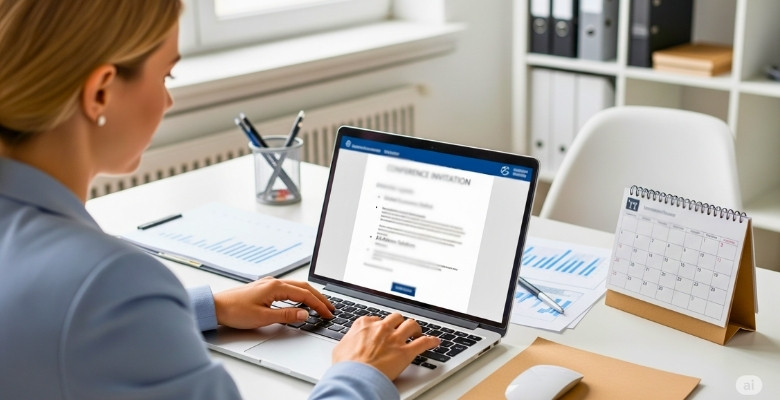A formal invitation letter for a conference isn’t just about sending details—it shows respect and sets the tone for the event. Whether you’re inviting a speaker, guest, or partner, the way you write matters. That’s why many people often wonder how to write a formal invitation letter for a conference.
To write a formal invitation letter for a conference, include your full name, job title, organization, and contact details at the top. Add the recipient’s name, title, and address. Use a respectful greeting. Mention the event name, date, venue, purpose, and their role. Offer support details, RSVP instructions, and close politely with your name and signature.
Do you want to know how to structure the letter step by step? If you’re curious about what to include and how to make the message sound respectful and complete, then keep reading—this article has all the important information you need in one place.
How to Write a Formal Invitation Letter for a Conference?
Every good event starts with clear and polite communication. A formal invitation letter shows respect and keeps things organized. It also helps your guest know all the important details in one place. Read the steps below to learn how to write it the right way.
Set a Professional Tone
Always try to sound polite and respectful from the beginning to the end. Write full words instead of short forms like “don’t” or “can’t.” Use proper titles such as Mr., Ms., or Dr. before the person’s name. Also, place your address at the top and write the full date under it. After the date, add the receiver’s full name and correct address for a formal format.
Include Sender Details
Your name and job title should come at the top of the letter. After that, include your office name, full address, email, and contact number. These details help the person know exactly who you are. It also lets them contact you if they have any questions. Make sure your information is clear and easy to read so there’s no confusion later.
Add Recipient’s Info
Make sure to include the correct name and address of the person invited. You should also add their job title and the name of their organization. These details show respect and keep the letter looking professional. Before the main message, use a formal greeting like “Dear Dr. Khan,” with a comma. Don’t use casual words like “Hey” or “Hi” when writing this kind of letter.
Start With the Introduction
Begin your letter by saying who you are and your role. Mention the name of your organization to give it more value. Then say you are writing to invite them to the event. Be sure to add the date, venue, and purpose of the event. If the invitation is for one of the upcoming conferences in Canada or any other country, add that naturally in the same paragraph.
Explain the Event
Tell the person what the event is about in simple words. Write whether they are being invited to speak, attend, or join a discussion. Let them know the event date, starting time, and exact venue. Try to include why they are important to this event. All this helps the person decide faster and gives them a clear picture of what to expect.
Offer Helpful Support
There are times when guests need help with travel or staying. It’s good to mention if you’ll provide a hotel room or a plane ticket. If they’re coming from another country, include help with visa letters. Some guests may also ask about payments or honorariums. So, if you are offering any support or money, state that clearly in this part of the letter.
Mention the Schedule
Instead of writing a full program, give them a short outline. You can tell them which day they’re needed or when they might speak. Say if there will be breaks, lunch, or group sessions during the event. This helps the person plan their time and travel better. You can also mention any evening programs or meetups if they’re part of the event.
Give RSVP Details
It’s important to ask the person to confirm their attendance on time. Tell them the date by which they should reply and how to do it. Add the name, email, and phone number of the person handling RSVPs. This helps avoid any confusion or delay in responses. Clear instructions make it easy for guests to get back to you quickly and politely.
Close Your Letter Well
Before ending the letter, remind them you’re excited for their reply. Use kind words to say you hope they can attend your event. After that, use a polite closing like “Sincerely,” or “With respect,” before signing. These small steps help you sound warm, formal, and thoughtful. Keeping the letter polite from start to finish leaves a strong impression.
Sign and Review
Finish by typing your full name, job title, and organization again. If the letter is printed, you should also sign it neatly above your name. Then read everything once more to check for mistakes or missing words. Make sure all names, dates, and details are correct. This final step shows that you care about doing things the right way.
Writing a good invitation letter doesn’t have to feel too hard. Just follow each part step by step with simple and clear words. This way, your guest will understand everything without asking again. Always check the letter before sending it to keep it perfect.
Sample of Formal Invitation Letter for a Conference
Date: [Insert Date]
To:
[Recipient’s Name]
[Recipient’s Designation]
[Institution/Organization Name]
[City, Country]Subject: Formal Invitation to Attend [Conference Name]
Dear [Recipient’s Name],
We are pleased to invite you to participate in the [Full Name of the Conference], which will take place from [Start Date] to [End Date] at [Venue/Location].
This year’s theme, “[Conference Theme]”, brings together leading professionals, researchers, and industry experts to share insights, present research, and explore solutions to pressing challenges in the field of [Field or Topic]. The event will feature keynote addresses, panel discussions, workshops, and networking opportunities.
We would be honored by your presence and believe that your experience and contributions would add great value to the conference.
Please find the detailed agenda, registration information, and travel details on our official website: [Insert Website URL].
If you have any questions or need further assistance, feel free to contact us at [Insert Contact Email].
We look forward to welcoming you to [City] and hope you will be able to join us for this exciting event.
Warm regards,
[Your Full Name]
[Your Job Title]
[Conference Organizing Committee]
[Organization Name][Full Address]
[Email Address][Phone Number]
Should You Mention the Conference Agenda in the Invitation Letter?
Writing an invitation letter sounds simple until you reach the agenda part. Some people leave it out completely, while others include too much. Finding the right balance can help the letter look better. If you’re not sure what to include, this will guide you.
Basic Details First
Describe the conference without explaining everything. You can just share the theme or two or three main topics. That keeps your letter short and still gives useful details. Sharing too much can make it hard to read quickly. You want the reader to understand the event at a glance. Focus on big ideas, not small schedule parts. A few strong details are always better than too many weak ones.
Keep It Interesting
Instead of listing everything, choose agenda points that grab attention fast. Interesting topics make people want to attend and learn more. Don’t use hard words or long phrases that confuse readers. Pick sessions that sound useful, fun, or important to the invitee. Your job is to make them say, “I want to be there.” Make sure it flows well with the rest of the letter as well. Small details can make a big impact.
Speaker Highlights
People like to know who is coming and what they will say. If you have expert speakers, you should mention them in a simple way. Say their name and their topic, but not their full history. This helps the reader feel more excited to accept the invite. Don’t overload the letter with long introductions. Just focus on what makes the speaker special. Give them a reason to look forward to that part.
Avoid Overloading
Many people add too many points and turn the letter into a schedule. It’s better to stay simple and make your key topics clear. You can leave out things like coffee breaks or small talk. Only include sessions that are helpful or really exciting. Think of it as a quick preview, not the whole plan. This also gives you more room to make the letter friendly. Let the event sound important without being too heavy.
Offer More Info
You don’t have to include every detail about the conference inside the letter. Instead, you can say more info is available if they want it. A short line like “Full agenda available on request” works well. This keeps the letter short, clean, and easier to read. It also helps when your agenda changes later. You won’t need to send a new letter. You only give more info to those who ask.
Every conference letter should feel clear and easy to read. Too many details can make the message feel confusing and heavy. A short and simple agenda section works much better for everyone. Always share more only when the reader really needs it.
How to Address Different Types of Recipients in a Conference Invitation Letter?
Writing an invitation letter depends a lot on who you’re writing to. Some people prefer a friendly tone, while others expect something more formal. That’s why you need to think about your words carefully. Keep reading to see how you can adjust your letter easily.
Professors and Researchers
Always show respect when writing to someone in an academic position. Keep your words clear and polite, and highlight how their ideas will help others. Mention the subject of the conference and how it connects to their work. Let them know their participation will be valuable for all attendees. When writing to keynote speakers or panel experts, keep your tone respectful and professional, especially since your approach may impact how they craft their acceptance letter for speaking invitation. Always end with thanks and offer to send more details.
Company CEOs
These recipients often have busy schedules, so get straight to the point. Explain what the event is about and how it fits their work. Let them know how their voice could make a real difference. Keep the message short but respectful, and use clear business-style writing. Show appreciation for their leadership and the knowledge they can share. Make sure they understand why they were chosen specifically. Invite them warmly, but don’t sound too casual.
Students and Interns
It is better to use a softer tone when inviting students or new professionals. Use kind and welcoming words that help them feel included. Explain clearly what the event is, where it’s happening, and why it matters. Tell them what they can learn and how they can join. Avoid complicated words or long phrases that they may not understand easily. Let them know you’re happy to invite them. Keep the message short and full of support.
Government Officials
These invitations must be written very politely, using proper titles and format. Let them know the event’s goals and how they connect to public interests. Mention if they’ve helped in the past or supported related programs. Give complete details like location, time, and who’s attending. Make sure everything sounds formal without being too stiff. Invite them with care and remind them of their important role. Always close with thanks and contact details for follow-up.
Sponsors or Partners
It’s important to show both thanks and excitement when inviting this group. Begin with a short note of appreciation if they’ve helped before. Let them know what’s new in this event and how they can take part. Offer ways to speak, present, or support the program in other ways. Tell them how their help makes a big difference. Keep the tone professional but friendly. Make sure they know how important their support truly is.
Different people need different types of invitations for better understanding. Always think about who you are writing to before you start. Use clear and simple words so they understand your message quickly. A good tone can help you make a stronger and better connection.
Common Mistakes to Avoid When Writing a Conference Invitation Letter
Writing a conference invitation letter might look easy, but small mistakes can change how it feels. A few missing details or wrong words can confuse the reader. Good planning makes your letter clear, friendly, and useful. Let’s go over what to avoid next.
- Unclear Dates: Always write the full date with day, month, and year clearly mentioned to avoid any confusion.
- Too Informal Tone: Keep your words polite and respectful to make your letter sound professional and serious.
- Missing Contact Info: Always add your phone number and email at the end so the reader can reply.
- Long Paragraphs: Try to break your letter into small parts to make it easier and quicker to read.
- No Purpose Mentioned: Say clearly why you’re inviting the person and what role they will play.
- Too Many Details: Avoid writing every single thing about the event, or your letter will feel too heavy.
- Wrong Spelling or Grammar: Read your letter again before sending it so you can fix any spelling or grammar mistakes.
A few small mistakes can make a big difference in how your letter feels. Keeping things simple helps people understand the message faster. Use easy words and share only the important details. Always check your letter before you send it.
Why Understanding the Recipient’s Perspective Improves Your Invitation Letter?
Most people don’t read letters the same way. Some look for respect, others want details, and a few may just skim quickly. That’s why it helps to think like your reader before writing. Let’s explore how this small shift can help.
Builds Better Connection
Your words can sound more real when you think about how the reader feels. If they are important guests, you’ll want to show respect in a warm way. If they’re first-time attendees, keeping your tone friendly can help. When crafting your message, consider how the reader might respond — some may even send a thank you letter for conference invitation if your tone is respectful and the invitation feels genuine. People like to feel seen, so keep their view in mind.
Avoids Wrong Assumptions
Not everyone will know your event details or your role in it. If you assume too much, they may get confused or feel left out. Instead, add just enough information to help them understand clearly. That’s why it’s useful to look at things from their side. When you see what they might not know, your letter becomes more useful. It also shows that you care about making things easy for them.
Improves Your Tone
Sometimes a letter can sound too stiff or too casual without you noticing. That usually happens when you forget who you’re writing to. If it’s someone older or in a senior role, a polite and formal tone works best. But for peers or younger guests, a light tone might feel more inviting. Matching your tone with their style can make the message feel just right. It helps your words land better.
Adds Meaningful Details
Thinking like the reader helps you choose which facts to include. You’ll know whether to highlight the venue, speakers, or topic depending on their interests. This makes your invitation more useful and more likely to be read fully. When they see something that matters to them, they’ll pay more attention. That extra effort often makes your letter stand out from others. It’s a small change that brings big results.
Encourages Better Replies
Clear and thoughtful messages usually receive a positive response. When people feel understood, they are more likely to respond quickly and politely. Your message can also help them decide faster whether they will join or not. If they like how the message sounds, they may even share it with others. Some may even ask for some more details, which keeps the conversation going naturally. That’s always a good sign.
Taking time to think about your reader can change everything. It makes your message feel real and respectful at the same time. Always write as if someone important is reading your words. A thoughtful letter always feels better to receive and reply to.
Commonly Asked Questions
If you’re writing a formal invitation letter for a conference, a few questions might still be on your mind. This FAQ section clears up those common doubts with simple, direct answers to help you move forward with confidence.
Can I Use Email Instead of a Printed Letter?
Yes, you can use email if the event is not very formal. Just make sure the message still looks neat and uses polite words. Always include all the important information like date, time, and contact details. It’s also a good idea to use a subject line that says it’s a formal invitation.
What Should I Write in the Email Subject Line?
Keep the subject line short and clear so the reader understands quickly. A good example is “Formal Invitation to Speak at [Conference Name].” Avoid using casual words or unclear subjects. This helps the reader take the message seriously from the start.
How Long Should the Letter Be?
The letter should not be too long or too short; just one full page is fine. Try to use short paragraphs so it’s easier to read. Focus on the most important details and leave out anything that’s not needed. Keeping it simple helps the reader understand it quickly.
What Format Should I Use for the Letter?
Use a clean and easy-to-read format that looks professional. Start with the sender’s information at the top, followed by the date, then the receiver’s info. Write everything left-aligned and use a simple font like Arial or Times New Roman. Keep spacing clear between each section.
Should I Use a Letterhead for My Invitation?
Yes, using a letterhead makes your letter look more official and trusted. It shows the name, logo, and address of your organization at the top. This helps the person know the letter is real and not fake. A letterhead also adds a neat and professional touch.
Can I Add a Map or Location Link in the Letter?
You can add a map link if the event is in a new or large place. This helps the guest find the venue easily without asking again. You don’t have to add a full map picture—just a Google Maps link is fine. Put the link near the event location details.
What If I Don’t Know the Guest’s Title?
If you’re unsure, try to find out by checking their profile online. If you still don’t know, use a general title like “Dear Guest” or “Dear Participant.” It’s better than guessing and writing something wrong. Try to be respectful, even if the exact title isn’t clear.
Can I Mention the Dress Code in the Letter?
Yes, if the event has a dress code, you should mention it clearly. This helps the guest come prepared and feel comfortable. Just write a short note like “Formal Dress Code Required” or “Business Casual.” Put it near the event details or in a small note at the end.
Is It Okay to Attach Other Files with the Letter?
You can add attachments like brochures or posters if they help explain the event. Make sure all files are clear and easy to open. Always mention in the letter what each file is for. This way, the reader knows what to check and doesn’t ignore them.
What If I Get No Reply After Sending the Letter?
Wait for a few days after the deadline before sending a follow-up. You can write a short reminder in a kind and polite tone. Sometimes people forget or miss emails, so it’s okay to check again. A simple message can help you get a clear answer.
Bottom Line
Every invitation letter says more than just facts—it reflects your tone and respect. When you think about the reader’s view and follow each step carefully, your message becomes clear and welcoming. If you’re wondering how to write a formal invitation letter for a conference, start by keeping it simple, polite, and clear about the purpose.
To end on a good note, always check for spelling, avoid too much detail, and use the right tone. Add full names, correct dates, and a kind closing line. These small things help build trust and make the letter feel personal. Good luck with your invitation!








